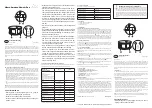
Instruction Manual
D200160X012
4195K Controllers
July 2018
49
The input element is connected to the process pointer and to the flapper by connecting links. As the process pressure
increases (in a direct‐acting controller). This movement restricts the flow through the nozzle and increases nozzle
pressure. When this occurs, relay action increases the output pressure (delivery) of the controller. Output pressure is
fed back to the positive feedback bellows. The action of this bellows is a positive feedback action that moves the
flapper closer to the nozzle, increasing nozzle pressure, which in turn, increases the relay output. Output pressure to
the final control element switches to full supply pressure.
Figure 5‐4. Fisher 4195KS Controller Schematic
SET POINT
INDICATOR
PROCESS POINTER
REMOTE SET POINT
CONNECTED HERE
INPUT ELEMENT
CONNECTED HERE
CONNECTING
LINK
FLAPPER
NOZZLE
PROPORTIONAL
BELLOWS
(VENTED)
POSITIVE FEEDBACK
BELLOWS
PROPORTIONAL
BAND ADJUSTMENT
SUPPLY
PRESSURE
RELAY
OUTPUT PRESSURE
TO FINAL CONTROL
ELEMENT
REVERSE ACTION
QUADRANT
FLAPPER
PIVOT
FEEDBACK LINK
FEEDBACK
MOTION
DIRECT ACTION
QUADRANT
INPUT MOTION
FLAPPER DETAIL
SUPPLY PRESSURE
OUTPUT PRESSURE
NOZZLE PRESSURE
POSITIVE FEEDBACK PRESSURE
B1546-2
As the process pressure decreases, approaching the lower switching point, the flapper moves away from the nozzle (in
a direct‐acting controller) reducing nozzle pressure. Through relay action, pressure to the positive feedback bellows is
reduced, moving the flapper further away from the nozzle, and further reducing nozzle pressure. Output pressure to
the final control element switches to zero.
The set point adjustment changes the proximity of the nozzle and flapper as does a change in process pressure except
that, when the set point is changed, the nozzle moves with respect to the flapper. The set point adjustment moves
both the upper and lower switching points.
The proportional band knob positions the nozzle on the flapper. Increasing (widening) the proportional band moves
the nozzle away from the input connection. When the proportional band adjustment moves the nozzle across the
feedback connection, the controller action changes between direct and reverse. On a direct‐acting controller,
changing the proportional band adjustment will widen or narrow the differential gap between the two switching
points. This is accomplished by moving the position of the lower switching point. On a reverse‐acting controller,
changing the proportional band adjustment will widen or narrow the differential gap between the two switching
points by moving the position of the upper switching point.
















































